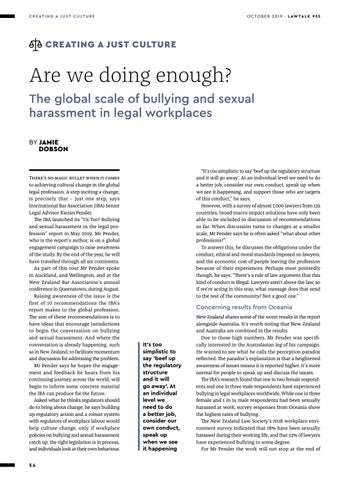CR E AT I N G A J U S T C U LT U R E
O ctober 2 0 1 9 · L AW TA L K 9 3 3
CREATING A JUST CULTURE
Are we doing enough? The global scale of bullying and sexual harassment in legal workplaces BY JAMIE DOBSON
There’s no magic bullet when it comes to achieving cultural change in the global legal profession. A step inciting a change, is precisely that – just one step, says International Bar Association (IBA) Senior Legal Advisor Kieran Pender. The IBA launched its “Us Too? Bullying and sexual harassment in the legal profession” report in May 2019. Mr Pender, who is the report’s author, is on a global engagement campaign to raise awareness of the study. By the end of the year, he will have travelled through all six continents. As part of this tour Mr Pender spoke in Auckland, and Wellington, and at the New Zealand Bar Association’s annual conference in Queenstown, during August. Raising awareness of the issue is the first of 10 recommendations the IBA’s report makes to the global profession. The aim of these recommendations is to have ideas that encourage jurisdictions to begin the conversation on bullying and sexual harassment. And where the conversation is already happening, such as in New Zealand, to facilitate momentum and discussion for addressing the problem. Mr Pender says he hopes the engagement and feedback he hears from his continuing journey across the world, will begin to inform some concrete material the IBA can produce for the future. Asked what he thinks regulators should do to bring about change, he says building up regulatory action and a robust system with regulators of workplace labour would help culture change, only if workplace policies on bullying and sexual harassment catch up, the right legislation is in process, and individuals look at their own behaviour. 54
“It’s too simplistic to say ‘beef up the regulatory structure and it will go away’. At an individual level we need to do a better job, consider our own conduct, speak up when we see it happening, and support those who are targets of this conduct,” he says. However, with a survey of almost 7,000 lawyers from 135 countries, broad macro-impact solutions have only been able to be included in discussion of recommendations so far. When discussion turns to changes at a smaller scale, Mr Pender says he is often asked “what about other professions?” To answer this, he discusses the obligations under the conduct, ethical and moral standards imposed on lawyers, and the economic cost of people leaving the profession because of their experiences. Perhaps most pointedly though, he says: “There’s a rule of law argument that this kind of conduct is illegal. Lawyers aren’t above the law, so if we’re acting in this way, what message does that send to the rest of the community? Not a good one.”
Concerning results from Oceania
It’s too simplistic to say ‘beef up the regulatory structure and it will go away’. At an individual level we need to do a better job, consider our own conduct, speak up when we see it happening
New Zealand shares some of the worst results in the report alongside Australia. It’s worth noting that New Zealand and Australia are combined in the results. Due to those high numbers, Mr Pender was specifically interested in the Australasian leg of his campaign. He wanted to see what he calls the perception paradox reflected. The paradox’s explanation is that a heightened awareness of issues means it is reported higher. It’s more normal for people to speak up and discuss the issues. The IBA’s research found that one in two female respondents and one in three male respondents have experienced bullying in legal workplaces worldwide. While one in three female and 1 in 14 male respondents had been sexually harassed at work, survey responses from Oceania show the highest rates of bullying. The New Zealand Law Society’s 2018 workplace environment survey indicated that 18% have been sexually harassed during their working life, and that 52% of lawyers have experienced bullying to some degree. For Mr Pender the work will not stop at the end of
